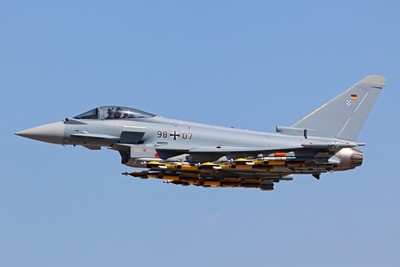Thu, Feb 24, 2011
Partner Companies Present Details At Aero India
More details about the studies conducted for the initial
definition of the "navalized" version of the Eurofighter Typhoon
were unveiled at Aero India 2011 this week.

Artist's Concept
These studies, conducted by Eurofighter and partner company BAE,
have included the assessment of required design changes, piloted
simulations to refine the aircraft's handling qualities and
discussions with key suppliers. The studies indicate that these
changes are feasible, and would lead to the development of a
world-beating, carrier-based fighter aircraft.
The most important element of the navalized Typhoon is that its
thrust-to-weight ratio allows the aircraft to take off from a
carrier without using a catapult but with a simple and much cheaper
"ski-jump". Detailed simulations have shown that the aircraft will
be able to take off and land in this way with a full weapon and
fuel load - providing a truly potent and flexible naval aviation
capability.

File Photo
The basic design of Typhoon helps to minimize the modifications
needed to allow a Typhoon to conduct naval operations from a
carrier. The aircraft's structure is exceptionally strong, having
been designed from the outset for the high dynamic loads associated
with extreme air combat maneuvering. The modifications required are
limited and include a new, stronger landing gear, a modified
arrestor hook and localized strengthening on some fuselage sections
near the landing gear, as well as updates the EJ200 engines.
To reduce the aircraft's approach speed and the resulting
landing loads the study envisages the introduction of a
thrust-vectored variant of the Eurojet EJ200 engine. Thrust
vectoring (Engines with TVN have already undergone factory testing
in the Eurojet facility) could be fully integrated into Typhoon's
advanced Flight Control System (FCS), allowing the pilot to focus
on flying the approach path while the FCS manages the engine nozzle
position. The ability to change the angle of the engines' thrust
will allow for a further enhancement in Typhoon's maneuverability,
supercruise performance, fuel consumption and the handling of
asymmetric weapon configurations.
Eurofighter says a key design driver for navalized Typhoon is
the commonality at 95 per cent with the land variant. Design
changes are minimized, allowing for most of the spare parts and
test equipment to be shared across a customer's air force and navy
fleets. The sensors, systems and weapons available to both variants
will be common, allowing for a reduction in the aircrew training
requirements. And in addition, the two variants will benefit from a
common upgrade path - new capabilities will be available to both
the air force and navy in similar timescales.
More News
Aero Linx: Commercial Aviation Safety Team (CAST) Founded in 1997, the Commercial Aviation Safety Team (USCAST) has developed an integrated, data-driven strategy to reduce the comm>[...]
Land And Hold Short Operations Operations that include simultaneous takeoffs and landings and/or simultaneous landings when a landing aircraft is able and is instructed by the cont>[...]
We're Everywhere... Thanks To You! Even with the vast resources and incredibly far-reaching scope of the Aero-News Network, every now and then a story that should be reported on sl>[...]
Pilot’s Inadvertent Use Of The Landing Gear Control Handle Instead Of The Flaps Selector Switch During The Landing Rollout Analysis: The pilot reported that during the landin>[...]
Also: Cosmonaut Kicked Out, Airbus Scales Back, AF Silver Star, Russian A-60 Clobbered A Samaritan’s Purse humanitarian flight was hijacked on Tuesday, December 2, while atte>[...]
 ANN's Daily Aero-Linx (12.12.25)
ANN's Daily Aero-Linx (12.12.25) ANN's Daily Aero-Term (12.12.25): Land And Hold Short Operations
ANN's Daily Aero-Term (12.12.25): Land And Hold Short Operations ANN FAQ: How Do I Become A News Spy?
ANN FAQ: How Do I Become A News Spy? NTSB Final Report: Cirrus Design Corp SF50
NTSB Final Report: Cirrus Design Corp SF50 Airborne 12.08.25: Samaritans Purse Hijack, FAA Med Relief, China Rocket Fail
Airborne 12.08.25: Samaritans Purse Hijack, FAA Med Relief, China Rocket Fail




